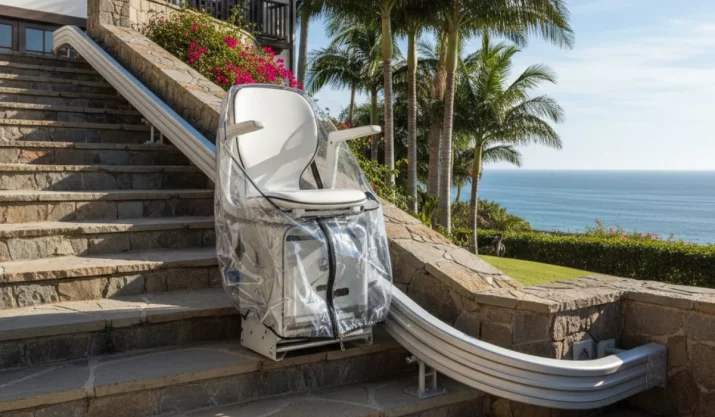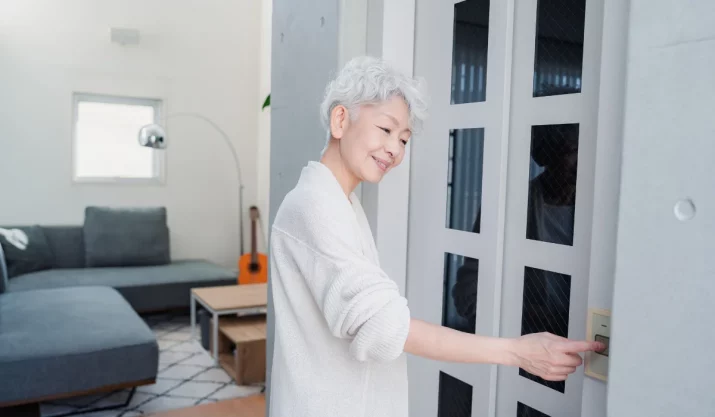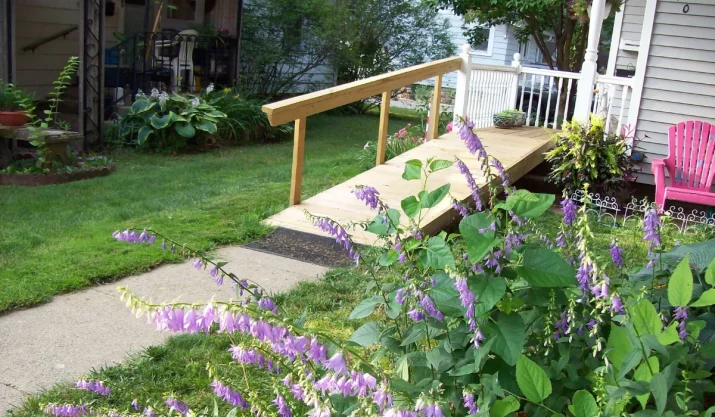Indoor vs. Outdoor Stair Lifts: What’s the Difference?
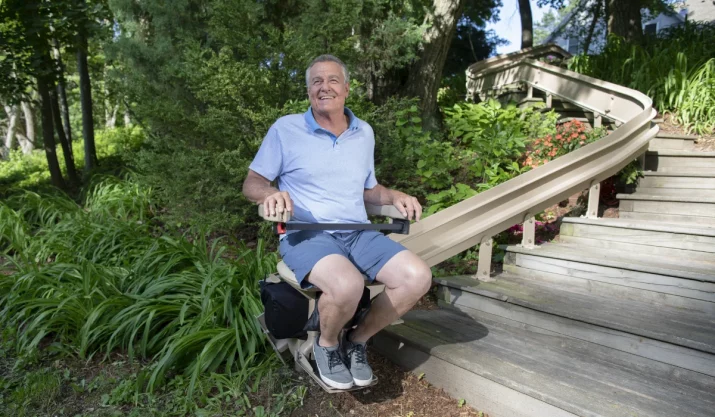
Table of Contents
If you or someone you care about is considering a chair lift, one of the first decisions to make is whether to opt for an indoor or outdoor model. Both lifts assist people with limited mobility in going up and down stairs. However, the design, features, and environmental settings of indoor and outdoor stairlifts differ for essential reasons.
In this guide, we’ll break down the key differences between these two types of stairlifts, including their materials, installation methods, and the safety features that matter most, particularly in changing weather conditions.
Key Takeaways
- Indoor and outdoor stair lifts serve the same purpose but are built for different environments. Outdoor models are more durable than indoor models, thanks to their weatherproof materials and sealed components.
- Straight stairlifts are ideal for straightforward staircases, while curved stairlift models are custom-made for stairs with turns or landings.
- Outdoor stairlifts cost more than indoor stairlifts due to weather-resistant construction and more complex pre-installation work.
- Choosing the right model supports independent living. This accessibility device can help you or your loved one safely navigate stairs without risk, whether inside the home or outside.
Indoor vs outdoor stair lift: what’s the real difference?
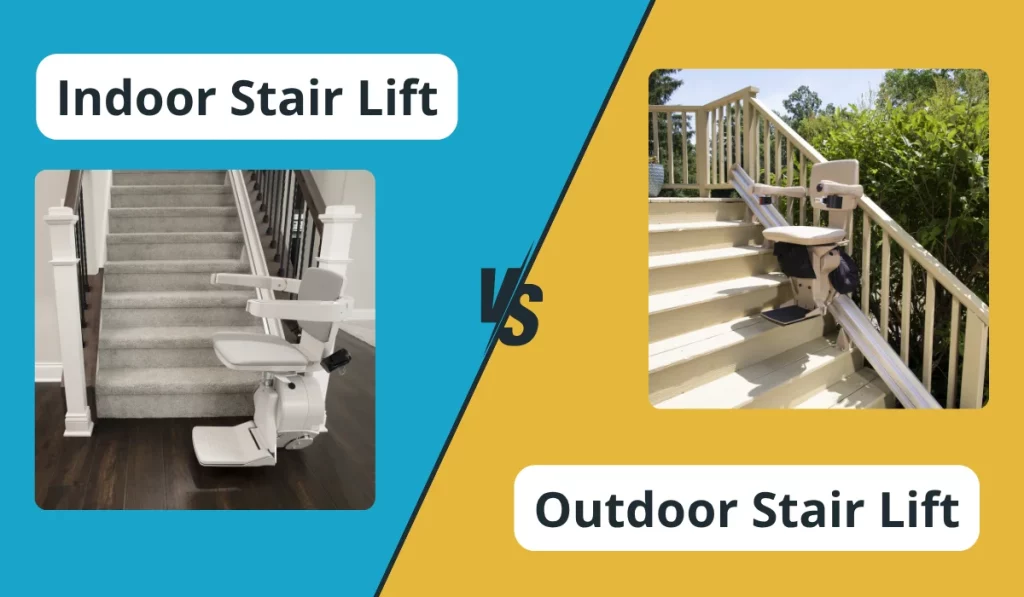
At first glance, all stair lifts might seem the same. To the unaware, all types of stairlifts are just a motorized chair on a rail that takes you up and down stairs. Indoor stairlifts and outdoor stairlifts have key differences that directly concern your safety, comfort, and the product’s longevity.
Moreover, there are several factors to consider before installing a chair lift in your home. For example, you must consider the space requirements this device needs so you and the stair lift’s user can both comfortably navigate your home’s stairs.
Stair lifts are a good investment if you have mobility issues or have parents who insist on living independently despite challenges, or plan to move your parents into your home.
Having indoor or outdoor stair lifts not only makes your home more accessible for yourself and guests with disabilities. It can also improve your home’s overall value.
Construction and materials
Indoor stair lifts are designed for temperature-controlled environments. These models often feature upholstery suited for interior decor. This type of chair lift may feature design elements such as padded armrests and adjustable footrests. It also typically features swivel seats that facilitate easier transfers for users, especially those with mobility issues.
Outdoor stairlifts, on the other hand, are designed to withstand harsh weather conditions. Rain, sun, wind, and salt air in places like Santa Cruz or San Diego can damage a regular lift. That’s why outdoor models come with:
- Weather-resistant or weatherproof coatings
- Sealed electronics and rust-resistant tracks
- UV-resistant plastic and protective covers to guard against the sun and rain
Suppose you live anywhere along the California coast or even in the mountains where the weather shifts quickly. In that case, your outdoor stairlift or vertical platform lift must be durable and weather-resistant. Anything less would be a waste.
Design for different stair types
Falls pose a greater threat to the health and mobility of seniors than any other issue. Installing the right chairlift for your home can prevent dangerous falls that may lead to serious injury and mobility challenges.
Whether you are getting a stair lift for in-home use or outdoors, they are available in two primary configurations:
- Straight stairlifts: These are designed for basic, linear staircases and are the most common and cost-effective choice.
- Curved stairlift models: Designed for stairs with turns, landings, or spirals. These require custom measurements and the fabrication of curved rails.
Outdoor staircases often have unique layouts, especially around decks or landscaped areas. In cases like this, you may need a custom, curved stairlift that is explicitly designed for outdoor use.
Comfort and usability features
Both indoor and outdoor stair lifts prioritize comfort and safety. However, the specifications of these stair lifts can vary.
Indoor models may offer upgraded upholstery, heated seats, and more style options to match your home’s decor. Other in-home chair lift features include:
- Fold-up footrests, armrests, and seats for narrow staircases
- Seat belts and safety sensors to detect obstructions
- Easy-to-use controls ideal for users with mobility issues or arthritis
Outdoor models tend to prioritize durability and offer fewer style options compared to indoor models. Chair lift models explicitly built for use outside your home can include features such as:
- Non-slip surfaces for wet conditions
- Locking covers for protection against tampering
- Simpler upholstery that’s easy to clean and maintain
Installation differences
Stair lift installation for indoor models typically takes just a few hours and is less complex, especially for straight staircases. The technician attaches the rail securely to the stair treads, ensuring it does not damage your wall. They will also provide guidance on how you can safely and properly operate the chair lift.
Installing outdoor models can take longer, as several factors can delay the process, including:
- Uneven concrete or wood stairs
- Weatherproofing around electronics
- Added structural support to handle temperature fluctuations
Installing chairlifts, especially the outdoor model, is best left to professionals. While DIY outdoor chair lift installation is possible, it is not recommended. Installing a stair lift can be complicated and unsafe if you don’t know what you’re doing.
To avoid safety hazards and potential damage to your property, contact a local expert who is familiar with California’s building codes and coastal conditions. Professional installers will make sure your lift is safe and reliable for years to come.
Cost considerations
Stair lift cost varies based on the type, brand, features, and installation complexity. Stair lifts can be costly upfront. However, the safety and convenience it will deliver in the long term will surely make up for it. Here are some ballpark figures to help give you an idea of how much a stair lift might cost you:
- Indoor straight stairlifts start around $2,500–$4,000
- Indoor curved stairlift systems can cost you $9,000 and up, depending on customization
- Outdoor models will typically cost $1,000–$2,000 more than similar indoor models because their weatherproof materials are more expensive. The extra prep work, which may include dealing with uneven surfaces, concrete, or outdoor conditions, will require more time and effort.
Brands like Bruno offer both indoor and outdoor models with warranty options that protect your investment. Be sure to factor in service, parts, and long-term maintenance when comparing options, as this will help you avoid future headaches.
When to choose indoor vs outdoor stair lifts
Choose an indoor stair lift if:
- Your stairs are inside a climate-controlled home
- You want a discreet, decor-matching lift
- You’re focused on features like swivel seating and extra padding
Choose an outdoor stairlift if:
- You need to access an outdoor staircase, such as from the driveway to the front porch
- Your home includes a backyard with elevation changes or a detached garage
- You’re concerned about safety during wet or icy months
In both cases, stair lifts can make independent living and aging in place possible by supporting the user’s loved one’s mobility needs, allowing them to navigate the home safely.
Final thoughts
Whether you’re dealing with temporary mobility challenges or preparing for aging in place, the right stair lift makes all the difference. Stair lifts for indoor or outdoor use may differ in many ways, but ultimately, these mobility devices offer comfort and safety. These devices can help you or your loved one navigate your home without the risk of falling.
At California Mobility, we can help you navigate your home, whether you have mobility challenges, disabilities, are aging in place, or simply want to continue independent living.
We offer a wide range of in-home stair lifts, like the Bruno Elite Curved Stair Lift and the Bruno Elite Straight Stair Lift. For outdoor accessibility, we offer the Bruno Elite Outdoor Straight Stair Lift and the Bruno Elite Outdoor Curved Stair Lift for your consideration.
Our products are durable, reliable, and easy to maintain. If you’re ready to make your home safer and more accessible, contact us today for a free quote. As Certified Aging-in-Place Specialists, we’ll help you find the right chair lift for your home and mobility needs.




